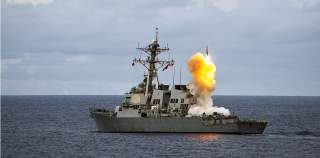The U.S. Navy Is Trying to Build What Could be the Ultimate Weapon: A Swam 'Ghost' Fleet
Swarms of aerial drones could, for instance, detect an enemy surface vessel and relay information to unmanned surface vessels or undersea drones to investigate or even attack.
“Right now, the sky is the limit, but, before we even get to that, we need to be able to have a more autonomous system that can steer and reposition itself,” Rucker said.
The ship is built to travel up to 10,000 miles while using sonar and other sensors to locate mines and even the quietest enemy submarines.
The Sea Hunter’s high-frequency sonar can send acoustic “pings” into the ocean before analyzing the return signal to determine the shape, size, speed and characteristics of any undersea enemy activity.
The 135-ton ship is engineered to withstand rough seas up to Sea State 5 – or waves up to 13 feet.
The 132-foot drone uses advanced hydro-acoustics, pattern recognition and algorithms for unmanned navigation to locate and shadow diesel-electric enemy submarines.
The idea is to track them, if necessary, over a period of months so they are compelled to stay away from strategically vital areas.
As technology evolves, the Navy plan is to rapidly migrate the system from something that is tele-operated to something that can increasingly perform a wider range of functions without needing human intervention.
“We are not yet at the point where we don’t have an operator supervising it,” Rucker explained.
Progress with the Sea Hunter will also involve replacing a turret on top of the drone with a range of sensors for ISR, surface-oriented technologies, weapons and electronic warfare systems, Rucker said.
“It will have an ability to work with the surface force, do command and control and go investigate,” Rucker added.
If the Sea Hunter is both more autonomous and armed with lethal weapons in the future, it will be engineered to align with current Pentagon doctrine which says any use of lethal force must hinge upon a human decision-maker in the role of command and control.
The Pentagon’s research arm is also extending testing of its sub-hunting drone able to travel autonomously for up to 90 days using sensors and sonar technology to search for enemy submarines and other airborne and undersea threats such as mines.
Navy Unmanned Surface Vehicle Master Plan:
Meanwhile, the Navy is also developing refueling Unmanned Surface Vehicles that are launched and recovered from a host ship. A refueling and data transfer system that is remote from the host ship and proximate to the USV operating area will allow a substantially greater fraction of a Navy USVs’ endurance to be spent on performing the mission rather than on non-mission activities associated with refueling, including transiting to and from the host ship and being deployed and recovered on the host ship.
This effort, asking industry to design, build, test and demonstrate a prototype USV to be called Offboard Refueling and Data Transfer System, or ORADTS. It will be designed to be more rugged and survivable than existing USVs and travel at longer ranges to extend mission possibilities.
“The ORADTS design must improve on previous designs by providing a more robust system that enhances system usability in higher sea states, reliability, and maintainability for implementation in Navy operations,” a Navy Broad Area Announcement states.
This initiative represents a portion of the execution or operational manifestation of a 2007 service roadmap called “The Navy Unmanned Surface Vehicle Master Plan,” which calls for the eventual combat deployment of a broad range of USVs to include ships for countermine missions, surface warfare, anti-submarine warfare, Special Operations support and electronic warfare, among other things.
Plans for USVs include a small “X-class” of boats, a 7-meter “Harbor Class,” a “Snorkeler-Class” and an 11-meter “Fleet-Class” boat, the master plan states.
The currently-sought after ORADTS refueling USV is slated to be a larger “Fleet-Class” USV.
“It is approximately 38.5 ft in length, 10.5 ft beam and full load displacement 21,400 lbs. It can carry between 400 and 650 gallons of diesel fuel marine (DFM) and uses fuel at a rate between 25 and 40 gallons/hr.,” Navy documents describe.
The refueling port of the USV is located on the starboard side of the craft, above the waterline, about midship. There will be up to 2 terabytes of data to be offloaded from the USV, per refueling iteration, the documents add.
This first appeared in Scout Warrior here.
Image Credit: Creative Commons.

